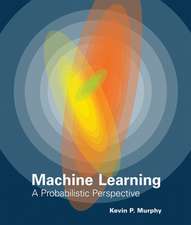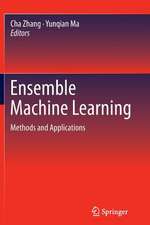Machine Learning of Robot Assembly Plans: The Springer International Series in Engineering and Computer Science, cartea 51
Autor Alberto Maria Segreen Limba Engleză Paperback – 5 oct 2011
| Toate formatele și edițiile | Preț | Express |
|---|---|---|
| Paperback (1) | 643.50 lei 6-8 săpt. | |
| Springer Us – 5 oct 2011 | 643.50 lei 6-8 săpt. | |
| Hardback (1) | 648.44 lei 6-8 săpt. | |
| Springer Us – 30 apr 1988 | 648.44 lei 6-8 săpt. |
Din seria The Springer International Series in Engineering and Computer Science
- 24%
 Preț: 1041.98 lei
Preț: 1041.98 lei - 20%
 Preț: 643.50 lei
Preț: 643.50 lei - 18%
 Preț: 1225.62 lei
Preț: 1225.62 lei - 18%
 Preț: 965.02 lei
Preț: 965.02 lei - 20%
 Preț: 646.12 lei
Preț: 646.12 lei - 18%
 Preț: 948.79 lei
Preț: 948.79 lei - 20%
 Preț: 646.62 lei
Preț: 646.62 lei - 15%
 Preț: 637.46 lei
Preț: 637.46 lei - 20%
 Preț: 643.83 lei
Preț: 643.83 lei - 18%
 Preț: 949.23 lei
Preț: 949.23 lei - 20%
 Preț: 644.48 lei
Preț: 644.48 lei - 20%
 Preț: 994.92 lei
Preț: 994.92 lei - 20%
 Preț: 645.97 lei
Preț: 645.97 lei - 18%
 Preț: 946.87 lei
Preț: 946.87 lei - 20%
 Preț: 995.57 lei
Preț: 995.57 lei - 18%
 Preț: 956.99 lei
Preț: 956.99 lei - 20%
 Preț: 644.98 lei
Preț: 644.98 lei - 15%
 Preț: 649.54 lei
Preț: 649.54 lei - 18%
 Preț: 950.21 lei
Preț: 950.21 lei - 18%
 Preț: 1221.38 lei
Preț: 1221.38 lei - 18%
 Preț: 957.62 lei
Preț: 957.62 lei - 15%
 Preț: 643.99 lei
Preț: 643.99 lei - 18%
 Preț: 948.47 lei
Preț: 948.47 lei - 18%
 Preț: 947.35 lei
Preț: 947.35 lei - 20%
 Preț: 1284.65 lei
Preț: 1284.65 lei - 20%
 Preț: 1628.31 lei
Preț: 1628.31 lei - 20%
 Preț: 1285.78 lei
Preț: 1285.78 lei
Preț: 643.50 lei
Preț vechi: 804.37 lei
-20% Nou
Puncte Express: 965
Preț estimativ în valută:
123.13€ • 128.57$ • 101.68£
123.13€ • 128.57$ • 101.68£
Carte tipărită la comandă
Livrare economică 15-29 aprilie
Preluare comenzi: 021 569.72.76
Specificații
ISBN-13: 9781461289548
ISBN-10: 1461289548
Pagini: 256
Ilustrații: XVIII, 234 p.
Dimensiuni: 155 x 235 x 13 mm
Greutate: 0.36 kg
Ediția:Softcover reprint of the original 1st ed. 1988
Editura: Springer Us
Colecția Springer
Seria The Springer International Series in Engineering and Computer Science
Locul publicării:New York, NY, United States
ISBN-10: 1461289548
Pagini: 256
Ilustrații: XVIII, 234 p.
Dimensiuni: 155 x 235 x 13 mm
Greutate: 0.36 kg
Ediția:Softcover reprint of the original 1st ed. 1988
Editura: Springer Us
Colecția Springer
Seria The Springer International Series in Engineering and Computer Science
Locul publicării:New York, NY, United States
Public țintă
ResearchCuprins
1 Introduction.- 1.1. Machine Learning.- 1.2. Robotics.- 1.3. About the Book.- 2 Scenario.- 2.1. Preliminaries.- 2.2. Specifying the Problem.- 2.3. Attempting to Solve the Problem.- 2.4. Observing the Expert’s Plan.- 2.5. Generalizing the Solution.- 2.6. Solving the Same Problem After Learning.- 2.7. Solving Similar Problems After Learning.- 3 Explanation-Based Learning.- 3.1. Similarity-Based Learning.- 3.2. Learning-Apprentice Systems.- 3.3. Explanation-Based Learning.- 3.4. A Prototypical EBL System.- 3.5. Issues for EBL Systems.- 4 The Arms World.- 4.1. Characterizing the Robot World.- 4.2. Simulating the Robot World.- 5 Learning And Problem Solving.- 5.1. Knowledge Representation.- 5.2. The Performance Element.- 5.3. The Learning Element.- 6 The Arms Implementation.- 6.1. A Note About the Implementation Language.- 6.2. Optimization Tools.- 6.3. Implementing the Solid Modeler.- 6.4. Implementing the Graphics Subsystem.- 6.5. Implementing the Schema System.- 6.6. Implementing the Top Level.- 7 Scenario Revisited.- 7.1. Attempting to Solve the Problem.- 7.2. Observing the Expert’s Plan.- 7.3. Verifying the Solution.- 7.4. Generalizing the Solution.- 7.5. Solving the Same Problem After Learning.- 7.6. Solving Similar Problems After Learning.- 7.7. Observing Similar Problems After Learning.- 8 Summary And Future Work.- 8.1. Relation to Other Work.- 8.2. Extensibility of ARMS.- 8.3. Future Research Directions.- 8.4. Conclusions.- Appendix A Solid Modeling Systems.- Appendix B Schema Semantics.- Appendix C A Simpler Example.- C.1. Describing the Initial State.- C.2. Attempting to Solve the Problem.- C.3. Observing the Expert’s Plan.- C.4. Verifying the Solution.- C.5. Generalizing the Solution.- C.6. Solving the Same Problem After Learning.- C.7. Solving SimilarProblems After Learning.- C.8. Observing Similar Problems After Learning.- Appendix D A More Complex Example.- D.1. Describing the Initial State.- D.2. Attempting to Solve the Problem.- D.3. Observing the Expert’s Plan.- D.4. Verifying the Solution.- D.5. Generalizing the Solution.- D.5.1. A More General New Schema.- D.5.2. A More Operational New Schema.- D.6. Solving the Same Problem After Learning.- D.7. Solving Similar Problems After Learning.- Appendix E Performance Considerations.- E.1. Learning Episode 1.- E.2. Problem-Solving Episode 1.- E.3. Problem-Solving Episode 2.- E.4. Problem-Solving Episode 3.- E.5. Problem-Solving Episode 4.- E.6. Learning Episode 2.- E.7. Learning Episode 3.- E.8. Problem-Solving Episode 5.- E.9. Problem-Solving Episode 6.- Appendix F Built-in Schemata.- F.1. State Schemata.- F.1.1. Joint Schemata.- F.1.2. Degree of Freedom Schemata.- F.1.3. Constraint Schemata.- F.2. Operator Schemata.- F.2.1. Primitive Operator Schemata.- References.
















